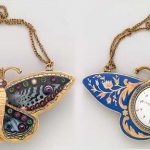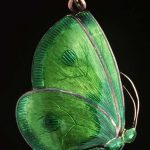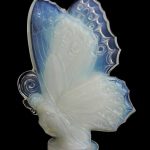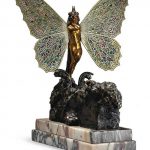Enamel Butterflies. The ancient Egyptians applied enamels to stone objects, pottery, and sometimes jewelry, although to the last less often than in contemporaneous cultures in the Near East. The ancient Greeks, Celts, Georgians, and Chinese also used enamel on metal objects.
Enamel was also used to decorate glass vessels during the Roman period, and there is evidence of this as early as the late Republican and early Imperial periods in the Levant, Egypt, Britain and around the Black Sea. Enamel powder could be produced in two ways, either by powdering coloured glass, or by mixing colourless glass powder with pigments such as a metallic oxide.
Designs were either painted freehand or over the top of outline incisions, and the technique probably originated in metalworking. Once painted, enamelled glass vessels needed to be fired at a temperature high enough to melt the applied powder, but low enough that the vessel itself was not melted.
Production is thought to have come to a peak in the Claudian period and persisted for some three hundred years, though archaeological evidence for this technique is limited to some forty vessels or vessel fragments. Reference: Wikipedia
Below are some examples of enamel objects with butterflies as part of their design.
A MATCHED PAIR OF CHINESE FAMILLE ROSE PAINTED ENAMEL WALL SCONCES QIANLONG PERIOD (1736-1795) Delicately painted in mirror image with a long-tailed bird perched on a prunus branch beside day-lilies, peonies and rocks below butterflies in flight, within elaborate floral borders, on which one has additional birds; with later European white metal detachable candleholders 22 in. (56 cm.) high overall
Sold for GBP 13,750 at Christie’s in 2019
Gold, Silver, Enamel, Diamond, Cabochon Gem-Set and Cultured Pearl Butterfly Bracelet Round & oval cabochon turquoise, opal, emerald, garnet & blue topaz, rose-cut diamonds, with hallmark, enamel loss, ap. 53.4 dwts. Length 7 inches.
Sold for $2,250 (includes buyer’s premium) at Doyle New York in 2018
A RARE CLOISONNÉ ENAMEL DISH. By Namikawa Yasuyuki, dated 1895. Worked in silver and gilt wire with butterflies over a clump of chrysanthemums, pink, begonia and dayflower beside a stream, the border of a linked kiku design, all reserved on a dark midnight blue background, the underside with a scrolling pattern in gilt wire, signed on a silver plaque, Kyoto Namikawa, the date,1895 in silver wire, applied a silver rim and foot, 15.2cm diameter.
Sold for £17,000 at Chiswick Auctions in 2019
Watch in the form of a butterfly ca. 1840–50 Swiss
Case of gold, enamel, and pearls
Reference: The Metropolitan Museum of Art
Butterfly pendant by Child & Child Made by Child and Child in London, Greater London, England, United Kingdom, Europe, 1891-1915. Sterling silver pendant in the shape of a butterfly in profile with wings folded upwards. Butterfly is decorated with shades of green enamel. Butterfly body is segmented into three green enameled sections with silver antennae connecting from upper head to wing. Gold ring attached to apex of wing. Original ovoid shaped hinged presentation box covered in green leather. Fawn coloured velvet interior surface on base in which a butterfly shaped depression houses the pendant. Replacement satin insert inside lid with ‘Anne Schofield Antiques’ printed in gold.
Reference: Museum of Applied Art and Sciences
Deep dish with overglaze enamel (wucai) decoration of chrysanthemum, poppy, and butterflies Chinese Qing dynasty, Kangxi period1662–1722
Ruyi fungus emblem inside double circle frame
Reference: Museum of Fine Arts Boston








